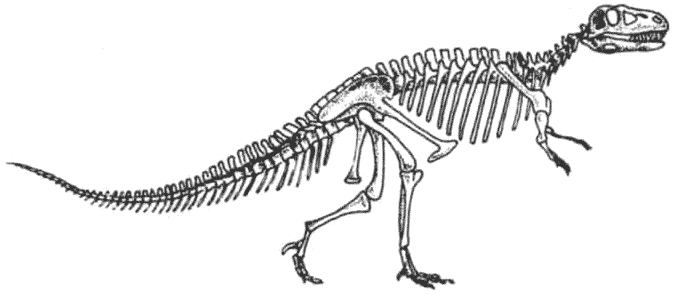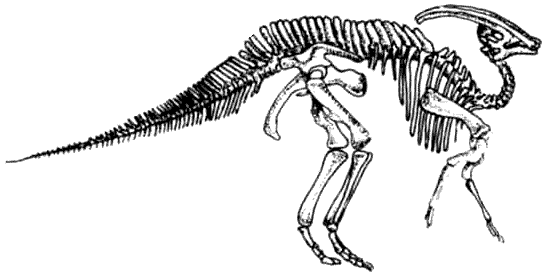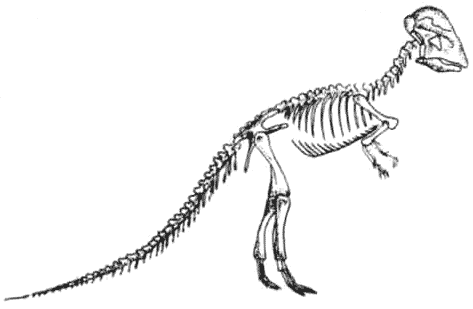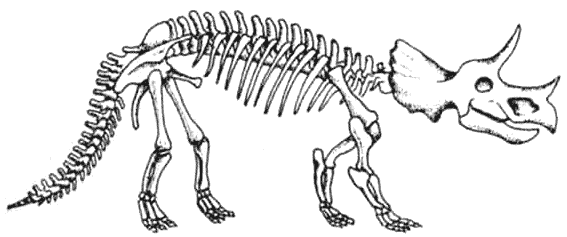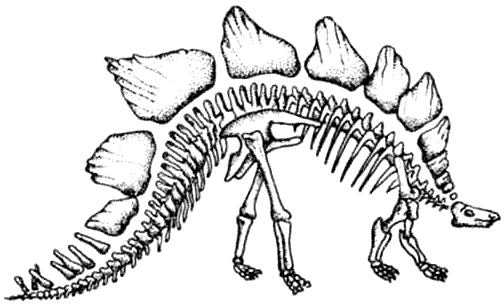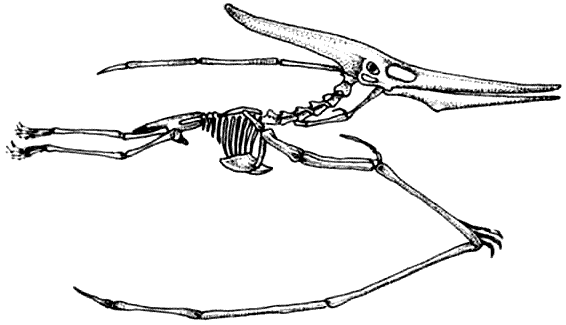| Main | Site library | Forum | Guestbook |
THE NEW
TREE OF LIFE
The continuation of the dinosaur lineage over the last 65 million years
has meant that these magnificent creatures have flourished, expanded and
diversified
with the same vigour as in the previous 150 million years. More so, in
fact, since the last 65 million years have witnessed sweeping changes
on the Earth’s surface.
Most of the dinosaur lineages had actually died out long before the end
of the Cretaceous period, and the dinosaurs that are alive today are
descended
from the most vigorous of the late Cretaceous groups.
The lightly built meat-eating saurischians, or ‘coelurosaurs’, that evolved
from the coelophysids have thrived, being very versatile and capable of
a great deal of evolutionary change.
The heavy meat-eaters, or ‘carnosaurs’, evolved from the teratosaurs, have
not fared so well. By the end of the Cretaceous period only the huge tyrannosaurs
were expanding. The megalosaurs, are maintaining their numbers but the
carnosaur line is not increasing significantly.
The prosauropods died out at the end of the Triassic, but their descendants
– the heavy long-necked plant-eating saurischians, or ‘sauropods’, became
abundant in the Jurassic period, but only existed in the late Cretaceous
period in places where they were not ousted by the ornithopods. Those that
survive today are mainly descendants of the titanosaurs and generally live
on the southern continents.
The small bipedal ornithischians – the ‘ornithopods’ – that evolved from
the heterodontosaurs (pages 14-15), like the small meat-eating saurischians,
have adapted and flourished, adjusting to the great changes in environment
with ease. Most of the plant-eaters today have evolved from this stock.
Ceratopsians – the horned ornithischians – were very successful at the
end of the Cretaceous and are still found in one form or another today.
The stegosaurs – plated ornithischians – had almost all gone by Cretaceous
times except for an isolated group in India. The group did not survive
the Ice Age.
Ankylosaurs – heavily armoured ornithischians – were a successful Cretaceous
group and have survived.
Then there are the flying pterosaurs. Despite competition from the birds,
the pterosaurs have survived.
Of the spectacular swimming reptiles, the long and short-necked plesiosaurs,
and the mosasaurs have survived, but the fish-like ichthyosaurs have become
extinct.
And the mammals? They began in the Triassic period as small insectivorous
creatures. By the end of the Cretaceous they were still small insectivorous
creatures. They have had no opportunity to expand and diversify, and are
small insectivorous creatures to this day.
 |
||||
|
|
|
|
|
 |
|||||||
|
|
|
|
|
|
|
|
The KRAKEN (page 107) and the COCONUT GRAB (page 99) are invertebrates descended from the cephalopods, therefore do not appear on this chart.
THE EVER-CHANCING LANDSCAPE
Throughout the main part of the Age of Reptiles, the continents had been
moving apart. During the Triassic period all the continents of the Earth
were fused together into one great supercontinent called Pangaea, consisting
of a northern section, Laurasia, and a southern section, Gondwana. During
the Jurassic period this supercontinent began to split up, and in the
Cretaceous period the separating continents were well on their way to their
present-day
positions.
Over the last 65 million years, since the end of the Cretaceous period,
the greatest movement of continents took place in the southern hemisphere.
At
the very end of the Cretaceous, the continent of Australia was still
attached to that of Antarctica. It subsequently split away and moved
northwards
until the continent reached its present position, in the southern tropical
climatic
belt. The continental block that now comprises India travelled northwards
across the Indian Ocean, and it finally collided with the huge northern
continent. As it split away from the original position as part of the
east African landmass,
it sheared away other continental fragments as well, and these have been
left as the islands, known as Madagascar and the Seychelles, and a number
of scattered submerged fragments. A seaway, called the Tethys, still
separated the continents we now call Europe and Asia from that of Africa,
but this
seaway slowly closed and narrowed. At the other side of the globe the
two continents of the Americas were quite separate, only connected by
a string
of islands during the earliest Tertiary times and with a permanent land
bridge developing quite recently. North America, however, was almost
permanently united with Asia across the Bering land bridge – a land bridge
that has
only
recently become submerged.
The continental movement had an effect on the climate. With a continuous
seaway around the world, made up of the Tethys and the gap between the
Americas, there was a constant westward flowing equatorial current driven
by the prevailing
winds. This brought warm, moist climates to the edges of most of the
continents. The water warmed in this current was swirled about to reach
up along the
coastlines in the north of the northern hemisphere and far down towards
Antarctica in the south. Climates were warm and equable and humid forests
grew on most
of the continents.
As the continents moved, the Tethys Sea closed up. At the same time Australasia
drifted away from the Antarctica and a circumpolar seaway opened up,
allowing a continuous eastward-flowing current to sweep around the cold
Antarctic
continent. The equatorial current was therefore lost, and consequently
the warm climates. There was now less mixing of warm tropical water and
cool
polar water, and climates increasingly differed over wide areas. The
drier, cooler conditions that resulted meant that the lush tropical forests
began
to give way to grasslands – a new habitat.
|
Pangaea
The Triassic period was the time when the supercontinent of Pangea was at
its most complete. It was divided into two huge sections, each section
far bigger than the greatest of today’s continents. The northernmost part,
consisting of modern North America, Europe and Asia, has been given the
name Laurasia. The southern section, consisting of South America, Africa,
India, Antarctica and Australia, is called Gondwana. An arm of the sea,
called the Tethys, reached in from the east and almost separated the two
sections. The rest of the sea area was united into a world ocean called
Panthalassa.
 |
Early Tertiary
As the elements of Pangaea separated, there was a clear seaway around the
world near the equator, with a westward flowing equatorial current that
modified the world’s climate.
 |
Late Tertiary
Continued movements closed the equatorial seaway and opened up a circumpolar
seaway around the Antarctic continent. Now the ocean circulation had no
unifying effect on the global climate.
The progressively cooler climates produced caps of ice at the poles of the
globe. The Arctic ocean was nearly land-locked and the constant inflow from
rivers diluted the salty water. As there was little mixing with warmer water
from the south, this northern ocean froze over permanently. In the southern
hemisphere the continent of Antarctica lay over the pole. This continent
was far away from the warm ocean currents and effectively insulated from
them by the circumpolar current. As a result Antarctica also froze over.
The climates continued to cool until the Ice Age, about 1.7 million years
ago. Glaciers swept south from the polar ocean and down from the mountains,
and the climatic zones were compressed upon one another towards the equator.
The topography of the world today is a direct consequence of this continental
movement. When a continent moves, it tends to accrete mountain ranges along
its leading edge. The greatest mountain chains of the Earth are the Himalayas
along the join between India and Asia, where the two continents converged
and collided 50 million years ago, and the Coast Mountains and the Andes
along the west coasts of North and South America, where the westward movement
is still taking place. The movement of the African continent against the
European has created some contorted mountain chains in that area, producing
the Atlas, the Appennines, the Alps and the other mountains that surround
the Mediterranean. The string of East Indian islands between Asia and Australasia
can be thought of as submarine mountain ranges, produced by the movement
of submerged continental masses and ocean floors. Most of the other great
mountain ranges of the world are old and worn away – relics of the continental
movements of former times. The old mountains of the Appalachians along the
east coast of North America were once continuous with the Scottish Highlands
and the Norwegian Mountains along the edge of northern Europe, before these
continents split apart. The Urals, the old mountain range between Europe
and Asia, demonstrates where these two continents collided 300 million years
ago. The movements that tore Pangaea apart are still at work. When a continent
splits, it rises into a ridge, and cracks along the crest. The east African
highlands represent such a rise, and the cracks are present as the Great
Rift Valley that runs up the length of the continent to the opening fissure
of the Red Sea.
 |
Modern plate movements
The Earth’s crust is still in motion, and the plates are still continually
shifting the continents. Along the active zones, where plates converge,
mountains and volcanoes can be forced upwards.
Continental movements have a great effect on the wildlife. A continent may move from one climatic area to another, and consequently the animal and plant life has to evolve to adjust to the changing conditions. In another situation, the continent may move up against a neighbouring landmass and the two populations mix. All these effects are taken into account in the concept of zoogeography, that determines what assemblages of animals live in which areas of the world.
THE WORLD DISTRIBUTION OF ANIMALS
Animals are not the same the world over. There are a number of rules that
define the kinds of animals that can live in one particular place and
not in another.
The most obvious factor that determines the animal life of a particular
area is the environment of that area – the climate, the terrain, the
plants that
grow there, other animals that exist there, in fact everything that contributes
to the surroundings and habitat. We can see straight away that an animal
that lives in a mountain environment, and is particularly well suited
to live in a mountain environment, will not survive long if introduced
into
a swamp region – and vice versa. A mountain animal's tolerance of high
altitudes would be useless in an area of low-lying wetland, and a swamp
animal’s stream-lined
shape would be quite out of place on craggy mountain peaks. Yet, despite
this profound influence of environment, a mountain animal may be quite
closely related to a swamp region animal that lives on the same continent.
They may
both have evolved from the same ancestor just a few million years ago.
On another continent on the other side of the world there may be mountain
animals
and swamp region animals that are likewise closely related to each other,
but these will be quite unrelated to those on the first continent. The
two mountain animals may look quite like one another, and the two swamp
animals
will share the same adaptations, but they will all have evolved quite
independently.
Grouping the animals of the world according to their evolutionary relationships,
rather than according to the environments in which they live, can divide
the world into convenient regions known as ZOOGEOGRAPHIC REALMS. Each
zoogeographic realm will contain a collection of animals that is peculiar
to itself and
that has evolved relatively independently from the animal assemblage
of another realm. The boundaries between the realms may be well marked,
as
by oceans,
or may be quite hazy, with several types of animals able to cross over
from one to another. The existence of the realms is effected by the natural
barriers
to migration that arise because of the physical geography. A mountain
range or a desert may divide one assemblage of animals from the next.
The ETHIOPIAN REALM consists of the majority of what we call the continent
of Africa. The northern boundary effectively runs through the Sahara
and Arabian deserts. Few animals can cross such a barrier, and the animals
to the south have tended to develop in isolation from those to the north.
The
island of Madagascar is part of the Ethiopian Realm, although it is isolated
from the continent and could be regarded as a little zoogeographic realm
in itself.
The PALAEARCTIC REALM consists of the continents of Europe and Asia north
of the Himalayas. It also includes the north coast of Africa. The Sahara
desert represents a more powerful barrier to migration than does the
Mediterranean Sea.

Environmental influence
During the Cretaceous the hypsilophodonts were very successful. A subgroup
– the thescelosaurs – evolved in North America. The balaclav and watergulp
are two thescelosaur descendants from the western realms. One lives in
mountains, the other in swamps, and so physically, they differ greatly
from one another. In the Oriental realm, the taddey and the glub are descendants
of the main hypsilophodont group. The mountain form reveals the same adaptations
as the balaclav, and the swamp form resembles the watergulp, but they are
not closely related.
 |
The zoogeographic realms
The landmasses of the modern world can be divided into six faunal zones,
or zoogeographic realms, each realm with a completely different animal
population. The boundaries between each realm are marked by barriers to
migration and usually consist of deserts, mountains or seaways. The boundaries
can be well-marked or indistinct. One great landmass on the globe – the
continent of Antarctica – is so devoid of life that it is not contained
in any of the zoogeographic realms.
The NEARCTIC REALM is the continent of North America, north of the Mexican
desert. This desert isolates the realm from the continent to the south. The
Bering strait isolates it from the Palaearctic realm to the north and west,
but this is a very temporary barrier and the two realms share similar features.
The NEOTROPICAL REALM consists of the continent of South America and the
island bridge of Central America. For most of the last 65 million years this
has been a separate island, but quite recently it connected with the Nearctic
realm and the creation of a land bridge has meant that the two realms are
not as distinct as they once were.
The ORIENTAL REALM consists of what we call South-East Asia. The area of
Asia south and east of the Himalayas, including most of the islands of the
East Indies, comprises the Oriental realm. The mountains in the north and
the desert in the west provide the barriers between this realm and the rest
of the continent.
The AUSTRALASIAN REALM is perhaps the most truly isolated of all the realms.
It has been an island continent ever since it was broken away from the continent
of Antarctica and both plant and animal life there has developed in its own
way.
To this list of six zoogeographic realms we have added a seventh, that of
the OCEANS. Unlike the continents, the oceans
are continuous and there are no physical barriers between one ocean and another.
Animal life found in the oceans tends to be widely distributed and based
upon temperatures and water conditions - in other words the environment –
rather than the evolutionary development of particular areas. On the continents,
the collections of animals found in each realm reflect the history of that
realm. They depend upon when and how animal life migrated to that particular
area and upon the subsequent development of environmental conditions such
as geographic and climatic factors, that influence the animals living in
that area.
In a world in which the dinosaurs and the other Mesozoic creatures survive,
the animal life is still subject to the constraints of modern zoogeography.
This book is divided accordingly. With no extinction of reptiles there has
been no development of mammal life, and no evolution of human beings, and
therefore no training of geographers. Hence the places of the world have
not been given the names that they are known by today. Therefore, for the
purposes of this book, we have dispensed with the common geographical names
that are based on cultural and political divisions and reflect human exploration
and history, and throughout we shall only refer to places in the context
of their zoogeographic realms.
CONTENTS
FOREWORD
THE GREAT EXTINCTION 6
WHAT IS A DINOSAUR? 10
THE NEW TREE OF LIFE 12
PALAEOGEOGRAPHY 16
ZOOGEOGRAPHY 18
THE HABITATS 20
THE NEW DINOSAURS 29
THE ETHIOPIAN REALM 30
THE PALAEARCTIC REALM 42
THE NEARCTIC REALM 54
THE NEOTROPICAL REALM 66
THE ORIENTAL REALM 78
THE AUSTRALASIAN REALM 88
THE OCEANS 100
CONCLUSION 108
AFTERWORD 109
GLOSSARY 113
FURTHER READING 115
INDEX 116
ACKNOWLEDGEMENTS 120


